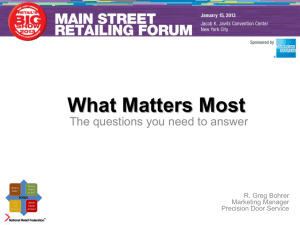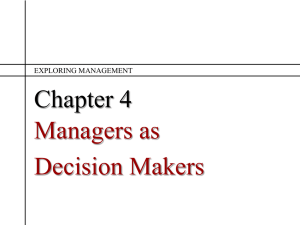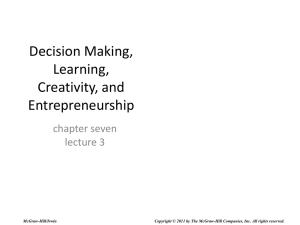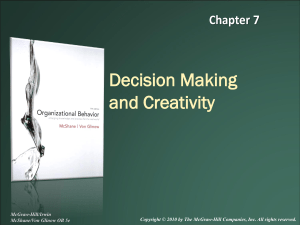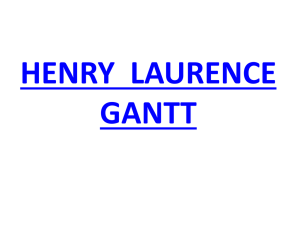slides
advertisement
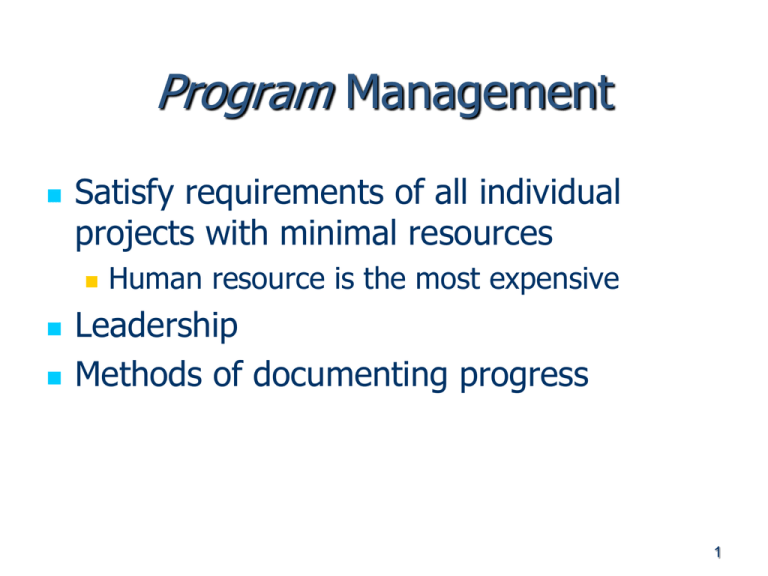
Program Management Satisfy requirements of all individual projects with minimal resources Human resource is the most expensive Leadership Methods of documenting progress 1 Project Management Manage individual project Work efficiently Monitor project progress Organize team members Document critical decisions Visualize Plan Implement Close 2 Multitasking Multiple projects, multiple tasks Multitasking? loss of focus Project management: avoidance of pressure on resources to multitask and ability to assess and direct the most beneficial use of resources when there is apparent contention for their attention 3 Critical Chain Scheduling and Buffer Management Too much time: work expands to fill time allowed. Too little time: detrimental pressures, behaviors and practices Buffers Assign skills rather than persons 4 Buffer Management Feeding Buffer Project Buffer 5 Project Management Tools Concept Fan FEMA Mind mapping Gantt Chart 6 Mind Map 7 http://www.spicynodes.org/blog/wp-content/uploads/2010/05/combating-global-warming-map.jpg Visualize Visualize Clearly picture your desired end result before you begin Project vision statement: Plan Implement Close Project definition (simple clear statement) Project expected results Should be specific, measurable, achievable, relevant, time-dimensioned 8 Plan 1. 2. 3. 4. 5. 6. 7. Visualize Plan Implement Close Prioritize Performance Factors Explore risk factors (FEMA) and alternatives Break projects into manageable pieces: a) major pieces, b) minor pieces, c) tasks Enter sequenced pieces / tasks into Gantt chart Clarify who is responsible for each task Prioritize and schedule the pieces and tasks 9 Determine project budget www.managementsupport.com Visualize Plan: 2) Risk Factors List the function of each component List potential failure modes Describe effects of the failures Determine failure severity Determine probability of failure Determine detection rate of failure Assign RPN 10 Implement Close FMEA stands for Failure Modes and Effects Analysis Methodology of FMEA: Identify the potential failure of a system and its effects Assess the failures to determine actions that would eliminate the chance of occurrence Document the potential failures Steps: Take action to reduce the highest risk Plan Design FMEA Analysis Item and Potential Function Failure Mode List Part Name, Number and Function List the possible modes of failure Potential Effects of Failure List the consequences of failure on part function and on the next higher assembly S Potential O Detection E Cause(s) C Method & V of Failure C Quality Controls List those such as: inadequate design, improper materials, etc. D R Recommended E P Actions T N List these measures available to detect failures before they reach the customer List them for each of the failure modes identified as being significant by the RPN = Critical characteristic which may effect safety, compliance with Gov. regulations, or require special controls. SEV = Severity rating (1 to 10) OCC = Occurrence frequency (1 to 10) DET = Detection Rating (1 to 10) RPN = Risk Priority Number (1 to 1000) 11 Visualize Plan Plan: 3) Break into Tasks Implement Close Mindmapping each major/minor piece to identify the tasks Break down the tasks as far as necessary for clear accountability Edit and sequence the tasks Example 12 Visualize Plan Plan: 4-7 Gantt chart: Put To-Do items into Gantt chart with detailed tasks for each person updated weekly. Software options include Implement Close Microsoft Project is preferable (available in ACS labs Free Gantt Chart software http://ganttproject.biz/ Word file Gantt chart template Weekly Status Reports 14 Visualize Plan Implementation Implement Close Milestones Formality, consistency, and discipline throughout the scheduling system 15 To be completed by next week and included in Report Gantt chart (all groups) FMEA or mind map or concept fan (at least one) 16 Concept Fan Why Look For Concepts? Identifying and working with concepts drives the generation of more ideas Identifying and working with concepts drives breadth in the thinking 17 Alternatives The Concept Triangle Concept Third Idea Second Idea First Idea or Alternative Purpose or Objective 18 1. What is the 2. Are there any concept behind the other ways to carry out that concept? idea? 3. Are there any other concepts? CONCEPT: Ways To Punish For Littering IDEA: Put Picture In Newspaper IDEA: Serve Time Picking Up Litter IDEA: Fine Those That Litter OBJ: Reduce Downtown Litter 19 Alternatives Selecting & Defining Concepts Be very precise about the concept Choose the concept carefully Look for multiple concepts Begin the concept statement with “Ways to…” or “Methods of…” and use at least 6-7 words 20 Alternatives The Concept Fan Purpose or Objective Concept First Idea or Alternative Second Idea Third Idea 21 Alternatives Key Things To Remember 1. Individual idea generation time is valuable to reduce channeling, maintain fidelity and drive efficiency. 2. Extract concepts from individual ideas. Do not group ideas first. 3. Then, find the Concept behind those ideas; try to make a lots of concepts. Don’t look for Similarities. Say: “Ways to….” 4. Then, generate more ideas for each Concept. 22 1. Who is this de Bono guy that you are talking about? Dr. Edward de Bono is a 70 year old Rhodes Scholar that was born in Malta. His background includes degrees in medicine, philosophy and psychology and faculty appointments in Oxford, Cambridge, Harvard and the University of London. With over 30 years of experience in consulting in business and education he is accepted as the world’s leading expert in the development of thinking skills in general and specifically creative thinking skills. 2. Why don’t we just do the brainstorming that we have always done? Brainstorming is a method that was developed in 1936 for the advertising industry. While there are a number of strengths inherent in the method, there are also some weaknesses. The Lateral Thinking skills capitalize on the strengths; even enhance them, while diminishing the weaknesses. 3. Won’t this take a lot longer? Speed isn’t the real goal. We are working on an important issue here and perhaps a bit more time using deliberate skills will bring us a better result. Can you at least give it a chance? 4. This seems really structured…won’t that inhibit our creativity? The belief that structure inhibits creativity is a flawed one. It is based on the assumption that all creativity comes from the removal of inhibitions. Just removing inhibitions in not enough. Without skills even the uninhibited individual will not be creative unless they have the “natural creativity” that very few individuals possess. With learned skills and deliberate structure we can harness and direct the application of those learned skills. 5. How come you want us to work alone? Seems like we are missing the opportunity to build on others ideas. Later in the process we will have the opportunity to collaborate in the way that you are used to – like brainstorming. However, we want your original thoughts first so that each of us can later build on all of the ideas that each of us might have. If we don’t work individually first we run the risk of channeling down a very few solution paths and might miss opportunities to broaden our overall thinking efforts. Additionally, we can simply get more ideas in the same time if we work individually – by working in parallel instead in serial. Lastly we want you to record your own ideas so that we get them recorded as accurately as possible. 23 Why can’t we just group the ideas we have generated into categories first in order to get the concepts? Grouping ideas after fact will lead to our finding a smaller number of concepts and they will tend to be at a very high level. This can easily inhibit our future efforts to get a more complete and robust solution set. 1. 2. What do you mean that we need to break down this concept because it is too broad? Why? If the concepts are too broad we might miss an opportunity. We want as many individual concepts as we can early on so that we have more “thinking paths” to explore. I don’t always get and idea when I try random entry. Am I doing something wrong? Remember that these techniques are not a guarantee of a creative result. However, they do increase the probability. We want to continue to make the deliberate effort knowing that we are increasing the probability by using the skills. 3. Creativity is a lot like R & D. We can’t guarantee that every time you put effort into R & D that we will get a result, but we can guarantee that if you never put effort into R & D, you will never get a result. 4. Why are we timing the use of these tools? Timing is one of the three disciplines of thinking – focus, method and time. Timing the application relieves the thinker of the responsibility and anxiety of always getting a result every time. It is best to use the skills for short periods of time and then go on to another skill or method. 5. These concepts are similar. Let’s just combine them. Combining similar concepts will result in concepts that are too broad to drive good thinking. When in doubt, if two concepts are similar, leave them separate in the hopes that even a small measure of difference will result in new and more ideas. 6. Why should we wait until next meeting to decide on what we want to do? We have some ideas to work with here. Allowing the thinking to perk or simmer for a while often results in more and better ideas. There is also the chance that others, outside the immediate team, will contribute. There is even the chance that accidental (or deliberate) random entry will 24 also help. 1. Why should we ask for input (ideas) from those other people? They don’t have any expertise in our field. Remember that even bad or flawed ideas could lead us to good concepts that will then lead to more and different and better ideas. Anyone might contribute an idea that eventually takes us to new concepts and then to new ideas. 2. How come everyone doesn’t get the chance to vote in this prioritization? In the selection or “narrowing down” process we are applying judgment. We want the judgment to be based of knowledge in the field. It is also good to have the people that will be responsible for implementation to be part of the selection process. This way we get their buy-in and implementation will be enhanced. 3. Why should we let the boss come in and look at this concept fan? We’re not finished yet. Eventually the boss (bosses or stakeholders) will receive our results and the more guidance they can provide along the way, the more likely we will be to produce a result that they can and will implement. Guidance at this point helps to focus our efforts in directions that have a greater chance of success. 4. We have selected these (top 6-10) ideas, so why don’t we just take the top one and go with it? Think of these ideas as being raw material that needs to be “processed and refined.” If we judge them now or try to implement them in their current form we might miss a great opportunity. We need to try to deliberately build each of these ideas into something better. We should also consider looking at sets of ideas instead of single ideas to make the final solution more robust. 5. Why do you say we need at least 6-7 words in the concept statements we write? Additional detail in a concept statement drives more concepts. It is better to have two or three clear concepts instead of a single vague one. With clear concepts our thinking efforts will be more productive and all team members can make the effort to generate ideas for each of the more specific concepts that come from a single vague concept. 25 LATERAL THINKING™ 1 Select & Define Area Focus Purpose Focus List Several Definitions Display Focus 3 2 Generate Ideas Challenge Alternatives/Concept Triangle & Fan Random Entry Provocation Movement A Alltteerrn naattiivveess F Fooccu uss General Area Focus - Defines the area, but not the purpose of the thinking. Purpose Focus - A specific purpose or desired outcome is defined or implied. Try alternative definitions C Ch haalllleen nggee Never An Attack Why C (Cut) - Can We Drop It? Why B (Because) - Are the reasons valid? Why A (Alternatives) - Immediately seek alternatives Capture & Work With Output P Prroovvooccaattiioon n Move back from the first idea or alternative to identify the overall concept or fixed point. This is termed concept extraction. Once the concept is identified, new ideas and alternatives can be generated and new concepts can be identified. Keep moving back and forth from concept to idea. A concept fan can also be used when a large number of different ideas and concepts are needed. New Ideas Concept Harvesting Treatment Assessment Arising - When a bold or unusual, but illogical idea is put forward (arises), not intended as a provocation, but is treated as one. Reversal - Simply reverse the normal direction of action to create instability. Escape - First, put down things taken for granted about the situation. Second, drop or escape from them to create instability. Wishful Thinking - Create a “fantasy” desire that is very bold to create instability. Start with “Wouldn’t it be nice if…” Exaggeration – Greatly exaggerate weights, speeds, dimensions, volumes etc. either up or down to create instability. R Raan nd doom mE En nttrryy Checklist Of Current Thinking Dominating Ideas Boundaries Assumptions Essential Factors Avoidance Factors First Idea Purpose/ Objective C Coon ncceep ptt F Faan n A graphical way to display and work with ideas and concepts to drive the development of more ideas. The focus is be displayed above concepts and concepts above ideas/alternatives. Extract the concepts from individual ideas instead of groups of ideas. 1. 2. Repeatedly Ask These Three Questions What is the overall concept behind the idea? Are there any other ways (ideas) to carry out the concept? Use a purely random method to get a word then simply let your mind move forward to connect up with a new idea. (extract a principle, broad direction or use simple association) Nouns are usually best. FOCUS/OBJECTIVE Concept Idea Idea Idea Concept Idea Idea Idea Idea Concept Idea Concept Idea Idea Idea Concept Concept Idea Idea Idea Idea Idea Idea Idea Idea 4 Results: Creative Thinking and New Ideas M Moovveem meen ntt Top-Of-The-Head - Make a general effort to move forward to an idea. No special process is necessary. Extract Something - Extract a concept, principle, feature or value and try to build a new idea around it. Focus On The Difference - Focus on the points of difference between the normal way of doing things and the provocation. Moment To Moment - Visualize in your mind the provocation being put into action and imagine what happens. Positive Aspects - Focus on the positive aspects of the provocation and attempt to move on to a new idea. Special Circumstances - Ask yourself if there are special circumstances where the provocation would have direct value. H Haarrvveessttiin ngg Specific Ideas - Immediately valuable, practical and usable Beginnings of Ideas - Not practical or usable, but interesting Concepts - Identify and extract any concepts from the ideas Approaches - Very broad concepts should be noted Changes - Note any changes in approaches or concepts Flavor - Note the general ”taste” of the entire session T Trreeaattm meen ntt Shaping - Use real life constraints to mold the idea Tailoring - Similar to shaping, but deals more with resources Concept Extraction - Identify the concept behind the idea Strengthening - Make a deliberate effort to strengthen the idea Fault Correction - Make a deliberate effort to correct faults Focus On The Difference - Focus on the difference between the usual way and the way being proposed. 26 Six Thinking Hats (Parallel Thinking) Elevator Speech References Six Hats is Framework for thinking in teams that results in better decisions in less time because it facilitates a much faster and more complete exploration of the issue/subject. With the framework, the thinking is broken down into smaller units making it far simpler. And… since the team members think in parallel…less time is wasted in argument and drift. Individual perceptions are shared quickly and argument is greatly reduced. I’m excited about what it has done in my team. Matthew Hedayatnia and MAE156B May I _____________________? Lateral Thinking Elevator Speech Lateral Thinking is a series of tools that teams…and individuals can use to help produce new ideas and concepts in an organized and directed way. The tools can be used in either virtual meetings or physical meetings. Individual thinking and group collaboration are both included in the process. And…you end up with a tangible documentation of the results that can be used or even archived for future reference. (I really like the fact that this approach to team creativity even appeals to technical people and that it doesn’t involve any silly games that make some people so uncomfortable.) I’ve been surprised and pleased with the results we‘ve been able to produce in my team. 27



